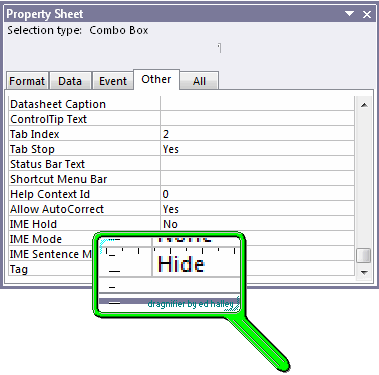

|
Book Use your pdf converter to make your pdf files easy! You can now buy software that makes converting pdf to doc possible! Did you know you can even convert pdf to word? Home Page Bloglines 1906 CelebrateStadium 2006 OfficeZealot Scobleizer TechRepublic AskWoody SpyJournal Computers Software Microsoft Windows Excel FrontPage PowerPoint Outlook Word Host your Web site with PureHost! |
Thursday, January 29, 2009 – Permalink – Sort FormsCreate a sorting functionHere is one way to provide your users with a means to reorder fields in forms."Chris Weber develops a solution that allows users to sort the data in their forms (or subforms) that you can add to your application easily.Let Your Users Sort it Out  Scroll down to the bottom of the page. There is a file that can be downloaded with the code. See all Topics access <Doug Klippert@ 3:04 AM
Comments:
Post a Comment
Saturday, September 13, 2008 – Permalink – Make Null ZeroIt's nothingWhen it is desirable to return a zero (or another value) rather than an empty field, Access (Visual Basic) has a function Nz(): Nz(variant, [valueifnull])
When you want to display zeroes in text boxes (or datasheet columns) when there is no value in a field, the standard method is to surround the value with the Nz() function, to convert a Null value to a zero. However, this doesn't always work, especially in Access 2003, which is much more data type-sensitive than previous versions. In these cases, you can force a zero to appear instead of a blank by using two functions: first Nz() and then the appropriate numeric data type conversion function, such as CLng or CDbl. Here is a sample expression that will yield a zero when appropriate: ACCESS Watch Vol 7 No. 5 See all Topics access <Doug Klippert@ 3:32 AM
Comments:
Post a Comment
Friday, July 18, 2008 – Permalink – Signing MacrosSecurity levelsThere are three levels of Macro security:
"If you've used Access 2003, you've probably seen several security warning messages - Access 2003 cares about your security. An important part of Access 2003 security is digitally signing your code. As Rick Dobson shows, you can do it, but preparing for digital signing is critical. Also: Other links: <Doug Klippert@ 5:01 AM
Comments:
Post a Comment
Sunday, April 13, 2008 – Permalink – Canada/US Postal CodesAutomatic Input masksIf you have a mix of Canadian and US postal codes, you might play with the following code inserted as a Country control "After Update" Event property.
See: Trinity University - San Antonio, Texas: <Doug Klippert@ 5:57 AM
Comments:
Post a Comment
Thursday, March 27, 2008 – Permalink – Entry CheckerA second chanceUnlike Word or Excel, Access does not warn you when data is changed. Unless you make a structural or code change, Access thinks you know what you want to know and allows you to enter or change data and the close the application without a squeak. There is a way around this: "In Microsoft Office Access 2007, by default, users are not prompted to confirm changes after modifying and saving records on a form. But often you might want to prompt users to confirm their changes before the record is saved. User Prompts (with a video) See all Topics access Labels: Macros, Properties, Tutorials <Doug Klippert@ 7:33 AM
Comments:
Post a Comment
Saturday, February 09, 2008 – Permalink – Display the Current Record NumberWithout navigationYou may want to remove the navigation buttons from an Access form but still display the current record number. Not the ID or serial number, but the record number that would appear in the navigation box.
<Doug Klippert@ 7:09 AM
Comments:
Post a Comment
Saturday, January 19, 2008 – Permalink – Convert Access Macros to VBAMacros to Modules
In 2007 go to Database Tools and look in the Macros group. <Doug Klippert@ 7:05 AM
Comments:
Post a Comment
Tuesday, July 17, 2007 – Permalink – Flag Access ControlsTag PropertyThe TAG property allows you to associate up to 2,084 characters of text with any form, report, section, or control. This is especially helpful when you want to single out a specific subset of controls. For instance, say that you want to hide certain controls on a form when a user clicks a button. You can flag which controls will be hidden by entering the word "Hide" (or any other consistent word) in each control's Tag property. Then, attach the following code to the command button's Click event procedure: Dim ctl As Control  See all Topics access Labels: Macros, Properties, VBA <Doug Klippert@ 6:42 AM
Comments:
Post a Comment
Friday, May 18, 2007 – Permalink – Highlight the Current ControlCode vs. property
Access allows you to do this with conditional formatting, but you can also get a similar result using code.
Function Highlight(Stat As String) As Integer
Click the Code button and insert Highlight("GotFocus")in each textbox control's GotFocus event procedure. Likewise, add Highlight("LostFocus")to each textbox's LostFocus event procedure. When you've finished,save the changes, close the VBE, and switch to Form view.
<Doug Klippert@ 6:14 AM
Comments:
Post a Comment
Monday, April 16, 2007 – Permalink – Time IntervalRun code at timed intervals
Labels: Macros, Properties <Doug Klippert@ 6:10 AM
Comments:
Post a Comment
Saturday, March 31, 2007 – Permalink – Comment CodeEdit toolbar
<Doug Klippert@ 7:05 AM
Comments:
Post a Comment
|